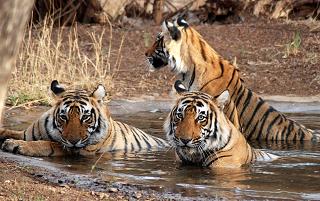
Welcome |
|
|
|
|
|
|
|
|
|
|
|
|
|
|
|
|
|
|
|
|
|
|
|
|
|
|
|
|
|
|
|
|
|
|
|
|
|
|
|
|
|
|
|
|
|
|
|
|
|
|
|
|
|
|
|
|
|
|
|
|
Ranthambore National Park |
|
Ranthambore National Park and tiger reserve is situated in the northwestern part of Rajasthan and is about 14 km from the town of Sawai
Madhopur. This park is surrounded by the Vindhya and Aravali hill ranges and is very near to the outer fringes of the Thar
Desert. Its deciduous forests were once a part of the
magnificent jungles of Central India. The terrain is rugged and
the hills, ancient sedimentary limestone and sandstone rocks,
perennial lakes and deciduous vegetation comprises of the
topography.
|

|
|
Ranthambore National Park was originally a hunting ground of the Maharaja of
Jaipur. Ranthambore was declared as a game sanctuary in 1955. In 1973 this reserve was protected under Project Tiger and in 1980, it became a National park.
The Ranthambore National Park is one of the state's well known tiger
reserve under the Project Tiger. Presently the Kaila Devi Sanctuary, also famous for its tigers and Mansingh Sanctuary also form part of Ranthambore Reserve covering a total area of 1334 square km. The core area is just about 392 square km.
The landscape, with its lakes, vegetation, the second largest banyan tree, and
the fort, make it one of the most picturesque parks in the country.
|
|
|
|
|
Major Attractions in the Ranthambore National Park |
|
Ranthambhore National Park is one of the best place to see the tigers, the majestic predators
and thus they are the main attraction of this park. This park has also
shown that the tigers can live and breed in close proximity to the human
settlements. The tigers can be spotted quite often even during the day, when they are hunting and taking care of their young ones. Other
wild animals found in the park are the Leopards, Caracals, Jungle Cats,
Hyenas, Jackals, Sloth bear, Deer, Antelopes, Nilgai, Sambhar, Chital,
Chinkara, Wild Boar, Porcupines, Indian Hare, Mongoose and Marsh Crocodile. The lakes and water holes in the Ranthambore National Park are the best places to sight the animals. These water bodies are full of lotus and water lilies. Resident and migratory birds can also be found in Ranthambore
National Park. There are about 264 species of birds found within the park.
|
|
|
|
Best Time to Visit Ranthambore National Park |
|
The best time to visit this park is from November to March. You can visit the park either by having a Jeep or a Canter Safari. There is a guide which will accompany you during the safari in the park. In the park, one must stick to the allocated route. |
|
|
|
Other
Attractions |
|
Ranthambore is a heritage site because of the picturesque ruins that dot the wildlife park. There are lake palaces,
'chhatris', old fortifications,
9th and 10th century temple and a majestic 1,000 year old Ranthambore fort, overlooking the park. The Ranthambore Fort was built by the Chauhans in the 10th century. The temples and tanks add to the beauty of the fort. The seven gates and massive walls, crowning a fall-topped hill presents a majestic view. |
|
|
|
|
|
|